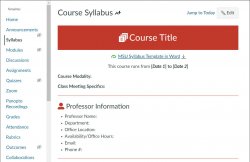Your course syllabus is a critical road map for students to gain an understanding of how your course structure, assignments, and schedule lead to meeting course goals. This includes sharing required materials, expectations for participation, how to reach you, assignment and grading details, and much more. A syllabus can serve many roles in setting the tone for a course including that of contractual agreement, a motivational encouragement, and scheduler.
The Canvas Syllabus Page
Canvas uses a page with a few additional features to display your syllabus. You may still upload your syllabus as a Word document or PDF and link it from this page. Canvas creates a course summary with your assignments listed in chronological order at the bottom of the page. The full Canvas Syllabus page can be viewed in our Canvas Faculty Orientation Course.

In addition to the Canvas Syllabus Page, faculty have the option to work with Simple Syllabus. Simple Syllabus is a centralized, template-driven platform that enables faculty to quickly personalize and publish interactive class syllabi. The new syllabus template was designed in collaboration with the Office for Faculty Excellence, the Office of the Provost, and a steering committee of faculty colleagues. Simple Syllabus is available in Canvas as “Montclair Syllabus” and can be enabled in Canvas course(s). Please visit our Simple Syllabus webpage to learn more!
Syllabus for Download
Download a syllabus template in Microsoft Word for you to use in your courses: Course Syllabus Template
It is designed in an accessible format. If you use your own format we recommend that you follow a few simple guidelines to ensure it is accessible to students using screen readers. Review our accessibility documentation and tutorials to assist you.
Syllabus Components
Syllabus as Contract
Syllabi have come to be thought of as a contract between students and instructors with ever-increasing pressure to cover all of the expectations and anticipated student questions. While syllabi may function as a contract regarding policies, it does not serve as a contract in terms of content. Your syllabus should contain language that notifies students that assigned material is subject to change.
Some contractual components may include:
- Expectations for attendance and class participation
- Policies on late work
- Policies on academic honesty and integrity including plagiarism and cheating
- Information regarding student’s rights and responsibilities
- Grading criteria for subjective assignments (including rubrics)
- The instructor’s availability and expected response time on emails/assignments
- Policies on providing accommodations for students with disabilities
- Information on university support services such as technical support and library resources
Syllabus as Motivator

A syllabus sets the tone for a course by introducing students to the topics to be addressed as well as to the instructor’s background and expertise. It is often the first impression a student has about a course and possibly the topics included in the course. This introduction should help motivate students to engage in the classroom or online activities and help students make connections to other programs, personal, and professional goals.
Instructors can present the course in such a way that encourages students to be excited about it (Harris, 1993). By sharing an overview of the topics included in the course, the purpose of the course, and learning goals, students will be able to make better connections to how they are being assessed. Additionally, the syllabus can help students take responsibility for their own learning (Grunert, 1997).
Syllabus Structure
There are several important components you will want to include in your syllabus. Below you will find a list of the main sections you should include when drafting your syllabus.
Course Information
Modality & Delivery
Professor Information
Description
Learning Outcomes
Schedule
Materials
Communication
Grading
Protocols
Accessibility
Support
The Canvas Syllabus Template is a great example.
- Fink, S. (2012). The Many Purposes of Course Syllabi: Which are Essential and Useful? Syllabus, 1, 1 – 12.
- Grunert J. (1997). The course syllabus: a learning-centered approach. Boston: Anker Publishing Co.
- Harris, M. M. (1993). Motivating with the course syllabus. National Teaching & Learning Forum, 3(1), 1-3.
- Schuman, R. (2014, Aug. 26). The Syllabus Tyrannus: The decline and fall of the American university is written in 25-page course syllabi.
- Slattery, J.M. and Carlson, J.F. (2005). “Preparing an Effective Syllabus: Current Best Practices.” College Teaching. Vol. 53, No. 4.
